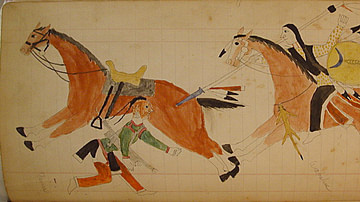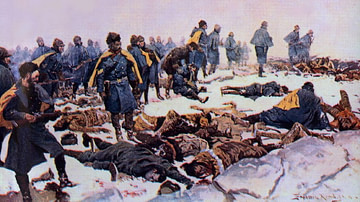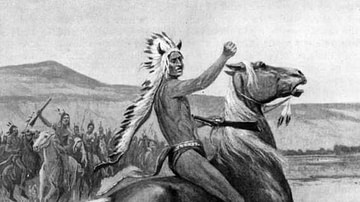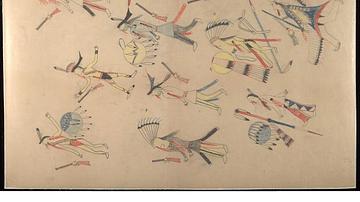How the Turtle Went to War (also Turtle Goes to War) is a Native American legend commonly associated with the Cheyenne, Arapaho, and Sioux nations, but the narrative also appears in the stories of the Blackfoot Confederacy, the Haudenosaunee (Iroquois) Confederacy, and others. It is among the most popular Native American tales and is often anthologized.
The details of the story differ, but all involve the Chief of the Turtles (Turtle Chief or Chief Turtle) declaring war on a nearby Native American village and the ensuing battle. The reason for the war is sometimes given as a response to the people overhunting and not respecting the turtle, though, in some versions, no reason is given at all. The Sioux version of the story, according to scholar Bobby Lake-Thom, gives the reason as:
The Indians had been greedy and killed more turtles than they could eat whenever they got lazy and tired of hunting. This made the Turtle Chief very angry. (156)
The version known as Turtle Goes to War claims that the turtles "had received many insults from men" and finally resolved to do something about it (AAANativeArts.com, 1). This version is also an origin tale explaining how Snapping Turtle and Box Turtle fell out during the campaign, and this is why these two types of turtles are never found in the same area. The events of the story are understood to have occurred in the distant past, before people recognized the spiritual power of the turtle and, perhaps, explain how they came to do so.
The Turtle in Native American Lore
The turtle is sacred to many of the Native peoples of North America and frequently features prominently in their creation stories. In the Lakota Sioux Creation Story, Turtle brings mud up from the bottom of the primordial sea for the Creator, Wakan Tanka, to make into dry land by building on the back of its shell. This same image appears in the creation stories of other Native American nations, as noted by scholar Adele Nozedar:
The creation myths of the east coast peoples, such as the Lenape and the Iroquois, tell that the Great Spirit built their ancestral lands by placing earth on the back of a colossal turtle; hence North America is sometimes given the name Turtle Island. There are many names for the turtle god: for the Hopi, he is Kahaila; for the Abenaki, he is Tolba; for the Mi'kmaq, he is Mikcheech. For the Seneca, the name for the animal is ha-no-wa, to differentiate it from the mythical turtle, whose name is hah-nu-wah. As a symbol, for Native Americans, the turtle stands for healing, wisdom, and spirituality, as well as longevity, fertility, and protection. (513)
Initially, however – in the long ago – this was not the case. Turtles earned the respect of human beings by asserting themselves under the leadership of Chief Turtle, although this is not explicitly stated in all versions of the legend. As with the stories of any Native American Nation, the tale of Chief Turtle's War offers many different possibilities for interpretation. It can be read as an origin myth, as a cautionary tale on the consequences of disrespecting the natural world, as a simple comedy, a satire of war and leadership (in the Turtle Goes to War version), as a hero's tale, and fits many other interpretations as well.
Text
The two stories given below are from the Cheyenne-Arapaho and the Sioux nations (How the Turtle Went to War), and the more widely known Turtle Goes to War, which has been attributed to the Sioux, the Iroquois, and other nations. As noted, there are many different versions of How the Turtle Went to War, but the one below is traditionally attributed to the Cheyenne-Arapaho and Sioux specifically while Turtle Goes to War is attributed to many different nations, who tell different versions, the Sioux being only one. The Cheyenne-Arapaho and the Sioux versions of How the Turtle Went to War are essentially the same except for the concluding paragraph. The alternate reading of this last paragraph is given below after the story.
This alternate ending provides the origin-myth interpretation of this version of the story as the Sioux never ate turtles, believing that doing so brought bad luck and could even result in sickness and death. Turtle Chief's last line, therefore, explains this custom: once the people stopped eating turtles, the turtles shared the secrets of their spiritual power.

The text of How the Turtle Went to War is taken from By Cheyenne Campfires by George Bird Grinnell. The alternate concluding paragraph comes from Spirits of the Earth: A Guide to Native American Nature Symbols, Stories, and Ceremonies by Bobby Lake-Thom. The text of Turtle Goes to War is taken from the site AAANativeArts.com.
How the Turtle Went to War
There was a great camp of water turtles and, not far away, some people were living – many lodges.
The turtle sent the pipe about to all the tribes of his friends and they all smoked, and all came to his camp. All the grasshoppers, frogs, snakes, butterflies, and rabbits – all the young men of these tribes – came in.
The head turtle spoke to all these people and said: "Now, let us go out on the warpath. I have found many Indians camping near this place. Let us go on the warpath against them and kill their chief."
All those to whom he spoke agreed. The grasshoppers, butterflies, frogs, and rabbits all were satisfied.
These warriors were camped in a big circle with the opening to the east. Before they started on their warpath, they all walked around within the circle and, afterward, around the outside of the circle, and then they started. Some of them carried war bonnets and other war clothing, such as Indians wear. They went on all night and, toward morning, while it was still dark, they reached the Indians' camp. The turtle went into the chief's lodge and took hold of the chief's throat and choked him and he died and the turtle bit off his hair. All the different warriors went into different lodges. When daylight came, the turtle leader crawled under the bed [of the slain chief] and stayed there all day.
In the morning, the chief of the Indians was found dead, and the old crier went about through the camp and called out, directing people to find out if there were any enemies about who might have done this thing. All the young Indians got ready and started out to look about and find out if near the camp there were any people who were on the warpath. The women acted as if they were frightened.
After the young men had gone, the chief's wife took down the lodge, for they were going to put the chief's body in another place. While they were moving the lodge, they found, under the bed, a turtle in the ground. He had not quite buried himself and someone saw the fresh earth and pushed a stick down and felt him. Soon, they learned that it was this turtle that had done the injury.
They chose another chief and called upon him to say what should be done. The chief said: Let us see what we can do to kill him. He is the one who killed our chief."
Some of the Indians said: "Let us put him in the fire!" but one said, "No, we cannot burn him, his shell is too hard. Let us cut his head off." Another said, "No, let us hang him" and a fourth said, "No, let us drown him." To all of them this seemed the best, and they decided that the turtle should be drowned.
Then, the next afternoon, they took him down to the water and a great crowd of people went with them to see him drown. The man who was going to drown him was painted up and he carried the turtle out to the center of the pond. The turtle acted as if he were very much frightened. As the man was going to let the turtle down into the water, the turtle turned his head and bit the man, and the man was frightened and sank into the water with the turtle. Then everyone on the shore was afraid and no one dared to go down into the water to help the man who had sunk.
After the turtle chief had drowned the man, he bit his hair off and waited and, after night came, he crawled over to where the chief's lodge had stood and found there the hair he had bitten off the chief's head. He started on his way home, and he was glad that he had done this thing all by himself. When he got home it was daylight. He took the hair and tied it to a stick and then he had two scalps to dance over, but his friends had not done anything. Still, for a long time, they went about the camp dancing and singing for joy. And he continued to be the chief of the turtles [for many years].
Alternate Concluding Paragraph:
The turtle stayed in the pond until night came; then he went back to the Indian camp and hunted until he found the chief's scalp. He was so quiet and had so much power that he could sneak past anyone unnoticed. He was proud that he had taken two scalps by himself. Then he went home and told his friends, but said: "Maybe one day the Indians will be our friends and we will share some of our secrets about power with them, just as long as they don't eat us anymore."
Turtle Goes to War
One time, that well-known brave, Snapping Turtle, became angry. All the people wondered why he acted so strangely. "Snapping Turtle is very cranky", said the other turtles, "Something must be in the air."
One day, a messenger came to all of them, calling each to appear at Snapping Turtle's wigwam. All the turtle people were glad and hoped that this meant that he would be in a good mood, so they came and feasted. Then Snapping Turtle said to them: "My brothers, I am angry at mankind. I am going to raise a war party and fight them."
All the turtles agreed that they had received many insults from men and were ready to go. That night, when everyone was asleep, the warriors started out to do battle. They traveled from dawn until dark and then they rested and slept. One of their number, the little Box Turtle, had a dream of bad omen. This made Snapping Turtle angry. He said that he did not believe in omens, and that he was determined to fight anyway. Each dawn, he called on his followers to narrate their dreams of the night before and, each morning, they had only bad omens to report. One morning, Box Turtle sang this song:
Oh, Snapping Turtle, I see you now
They are throwing all of us turtles in a sack!
"Don't sing that!" hissed Snapping Turtle. But Box Turtle continued to sing, so Snapping Turtle went up to him and kicked him but found that Box Turtle was singing in his sleep. The blow struck Box Turtle on his chest so hard that it broke his shell, and you can still see the break - the hinge of the shell on his chest – to this very day.
Snapping Turtle said, "Next time, Box Turtle, you will sing `Snapping Turtle is brave and cleans up all the villages wherever he goes.' I don't want you to sing that I get my people thrown into a sack. It is a bad song. Instead, sing that I am the one who makes a clean sweep wherever he goes and throws the enemy into hysterics."
Box Turtle was indignant and answered: "I don't want your people put in a sack. This is not my fault. I was asleep and the dream I sang about came out that way. Who am I to control my dreams?"
Again, they started out to war and, at last, they arrived at the Indian village. The turtles gave their war whoop and charged the village. All the women ran out of the wigwams. "Oh! Look at the turtles," they cried. They all ran for their sacks and threw the turtles in them. Box Turtle was safe because he had been so badly hurt by being kicked by Snapping Turtle that he had fallen behind.
One of the turtles named Painted Turtle was so prettily marked with red that the woman who picked him up hugged him close to her. He bit her – and she threw him into the water – where he escaped. The other women carried their captives home and were very angry about the blow that the one turtle had struck. They had captured Snapping Turtle along with all the other turtles and held council to decide what to do with him to punish him for attacking them.
One said, "Let's burn him to death, he is our enemy!"
Snapping Turtle thought, "That will be good!"
"No," said the council. "He will like that! He thinks that he will be able to kick the fire all over and thus destroy our lodges."
Another said, "Let's shoot him with arrows!" Snapping Turtle said, "Oh, yes, that is the best way to kill me." But – "No," said the council. "The arrows will bounce off your shell and others might be hurt."
Another woman suggested, "Let's boil him in a big clay pot." And Snapping Turtle answered, "I would be glad to die that way!" But – "No," announced the council. "He thinks that he will be able to spatter boiling water over us and scald us to death."
"In that case," said another, "Let us throw him in the river!"
At these words, Snapping Turtle and all his followers began to beg for mercy and plead that they not be drowned. They claimed that this was an awful punishment. The women thought that at last they had hit on the right thing and tossed every turtle into the lake. But, really, those turtles lived in water and they all escaped. And they would pester the women by messing up all the fresh springs where they went to get their water.
The men of the Indian village could not believe that the turtles had deceived their wives until, one day, they saw a whole lot of turtles enjoying the sun on a log. The snappers lived in the springs under the mud and the people learned that turtles cannot be drowned.
After their escape, the turtles held a great victory dance at Snapper's house and the Red Turtle was the hero because he had had a victory by biting one of the women when she hugged him. Snapping Turtle and Box Turtle have never been able to get along since that war party; and they won't even live in the same area as each other since then.






